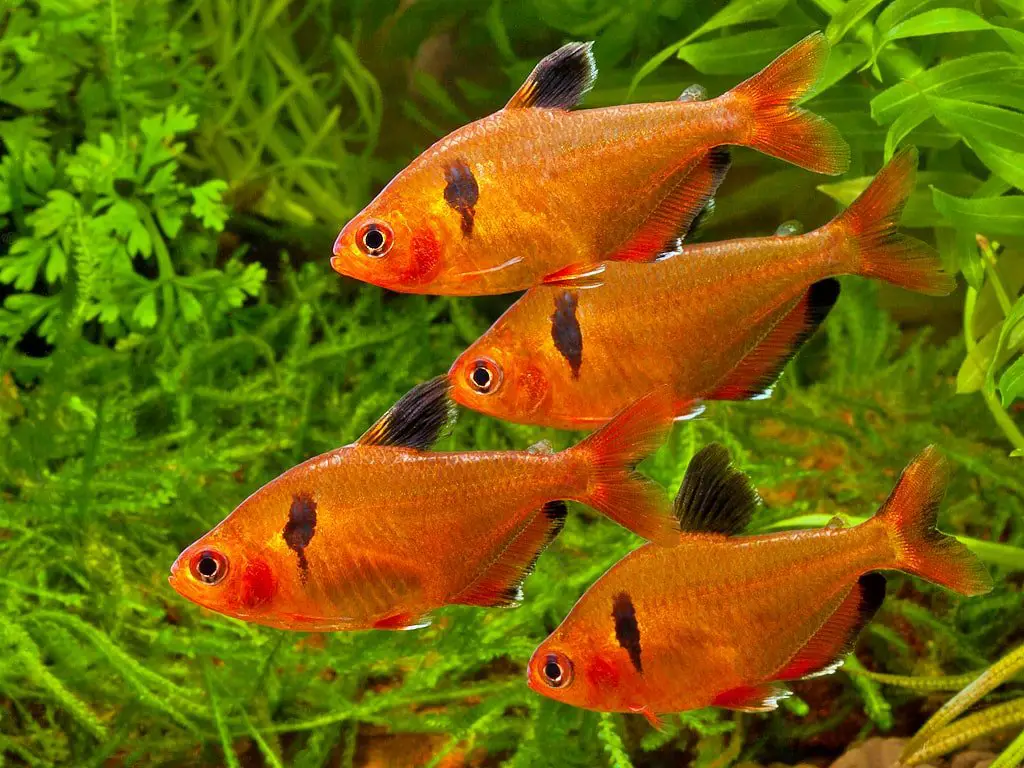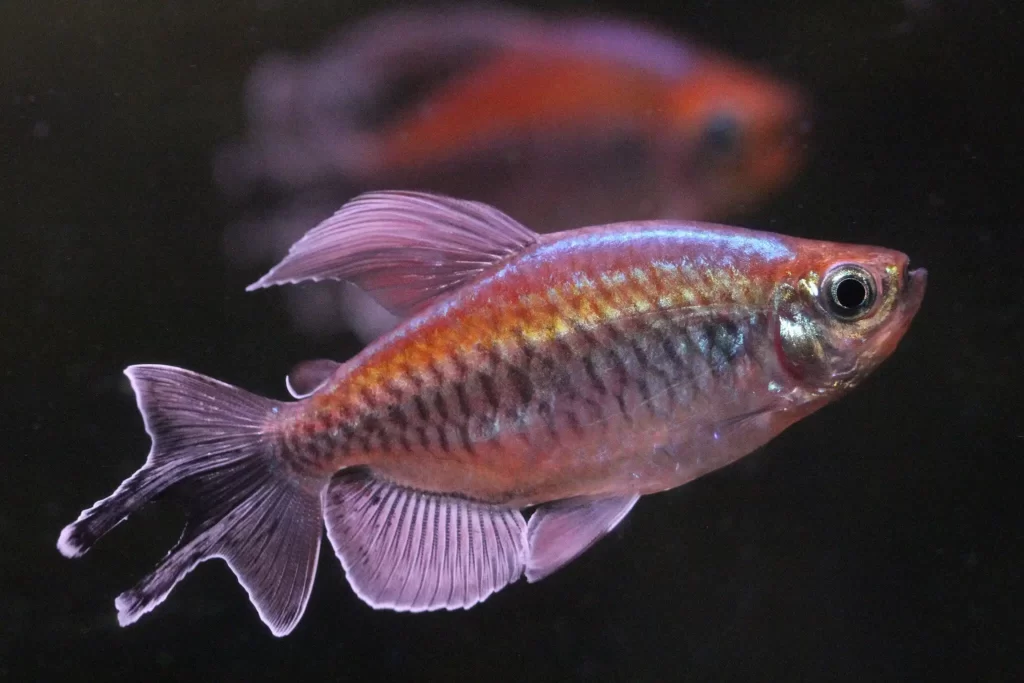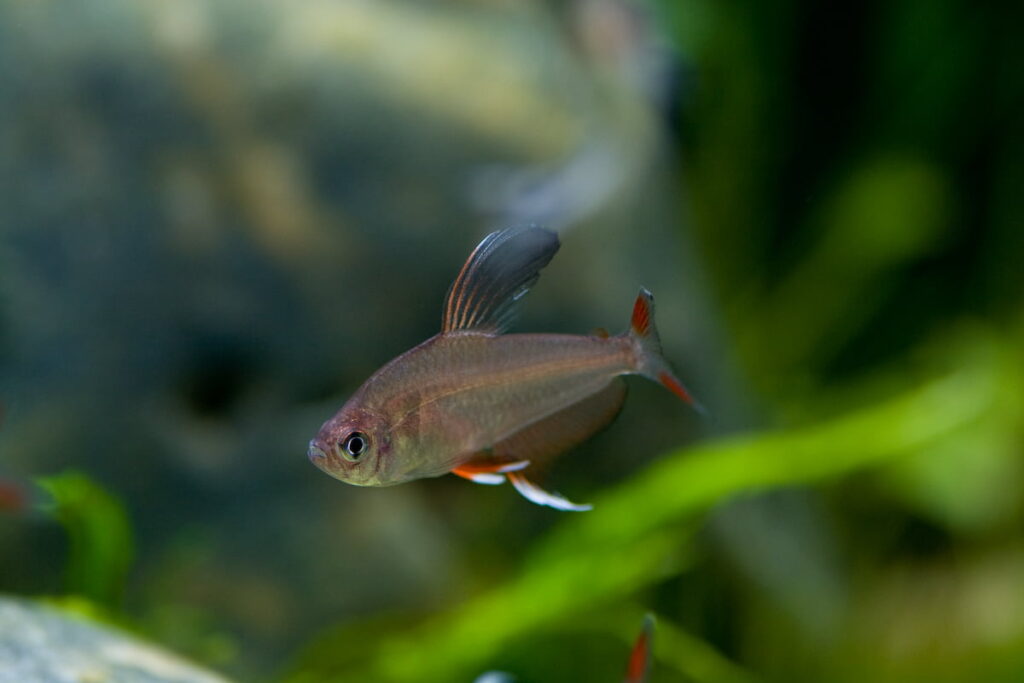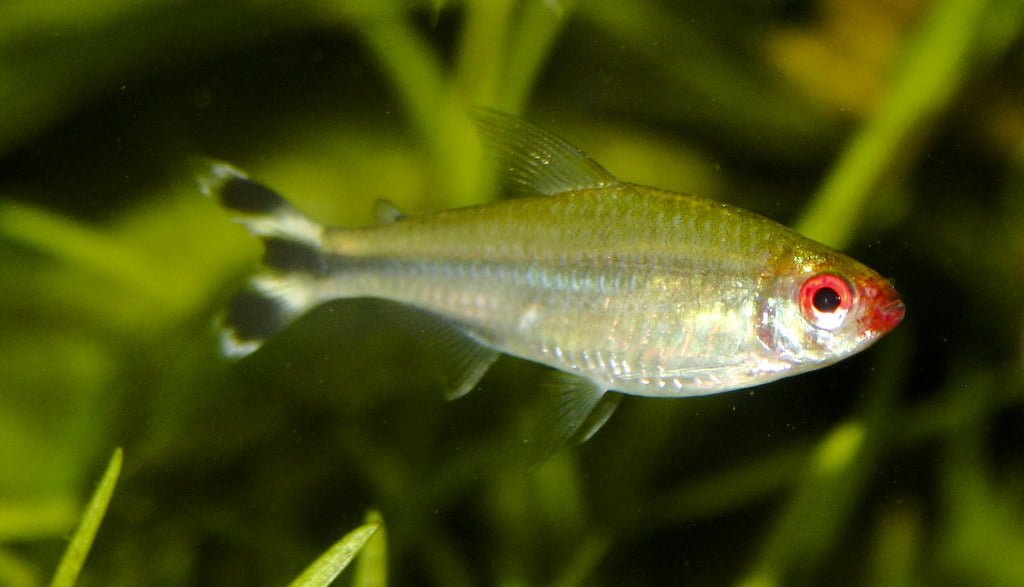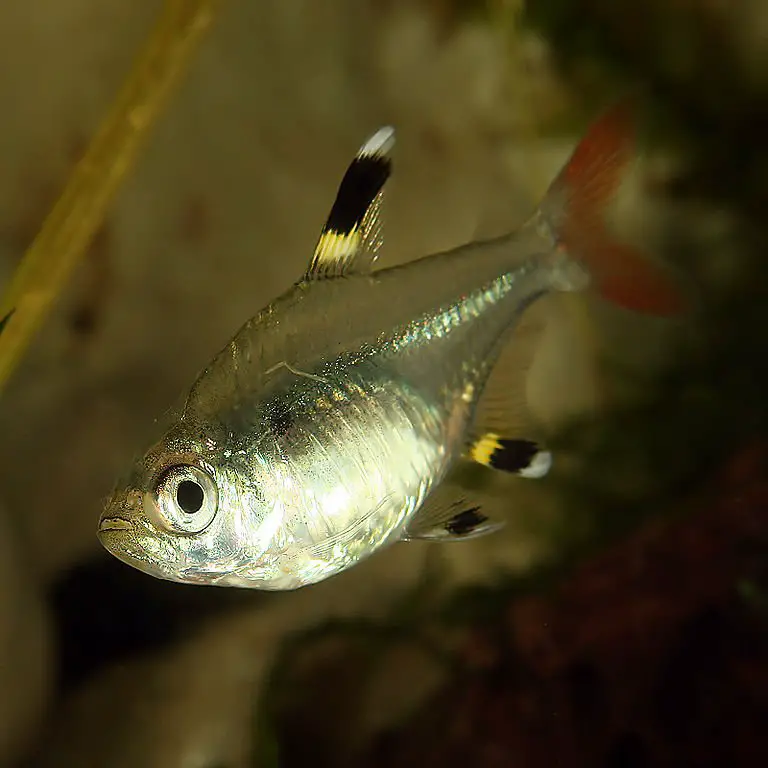There are several biodiversities in the world, of which we are aware of only a few. Fish are one of the magnificent diversity present in the world. There are about 28,000 different species of fish known to us. And among these species of fish, Tetra fish are quite popular among beginner aquarists. There are about 700 extant species of tetra fish, and one of them is Serpae Tetra (Hyphessobrycon eques).
The common names of Serpae Tetra (Scientific Name: Hyphessobrycon eques) are blood characin, Callistus, Callistus Tetra, Jewel Tetra, Red Minor Tetra, and Red Serpae. And the fish belongs to the Characidae family.
One of the main reasons that the Serpae Tetra is so popular is because of its deep red color with gray fins. It makes the aquarium brighter and more attractive.
Here, today we will be discussing Serpae Tetra in detail so that you have a basic knowledge of the fish to keep healthily and happily in your tank. I will try my best to give in all the knowledge that I pursued keeping this fish as my pet buddy, and from my research as well. Keep reading to know more.
| Category | Rating |
|---|---|
| Scientific Name | Hyphessobrycon eques |
| Common Names | Jewel Tetra, Red Minor Tetra, Longfin Serpae |
| Origin / Habitat | South America |
| Family | Characidae |
| Color Form | The longfin tetra has rose color in its body. And its fins of the longfin tetra are clear white. |
| Adult Size | 1.5 inches (4 cm) |
| Lifespan | 5 to 8 years |
| Fish Behavior/Temperament | Fin nippers |
| Water Temperature | 72°F - 79°F (22°C - 26°C) |
| Water Hardness | 10° to 25° dH, |
| Water pH | 5 - 7.8 |
| Water Movement | Keep the water movement moderate. You can tell current is too much if you see your fish laying flat against the aquarium glass. |
| Lightings | Requires the lights to be on at least 11-13 hours a day. Light will aid them in maintaining their circadian rhythm. |
| Tank Region | Middle to bottom |
| Tankmates | Other Tetras, Catfish, and Plecos, Swordtails. |
| Diet and Food | Omnivore; accepts any form of food like live food, frozen food, flake food, and pellets. |
| Gender Difference | Difficult to determine. However, female may have more rounded body. |
| Breeding Difficulties | Easy to Moderate. maintain ph between 6.5 and 6.8. |
| Tank Setup | Freshwater[Planted] |
| Disease | Dropsy, Gill Parasites, Ammonia Poisoning, Furunculosis, Fish Fungus / Fungal Infection, Velvet, Fish Lice, Pop-Eye, etc. Learn more about:- Tetra Fish Disease and Treatment. |
| Aquarium Size | 10 gallons or larger. |
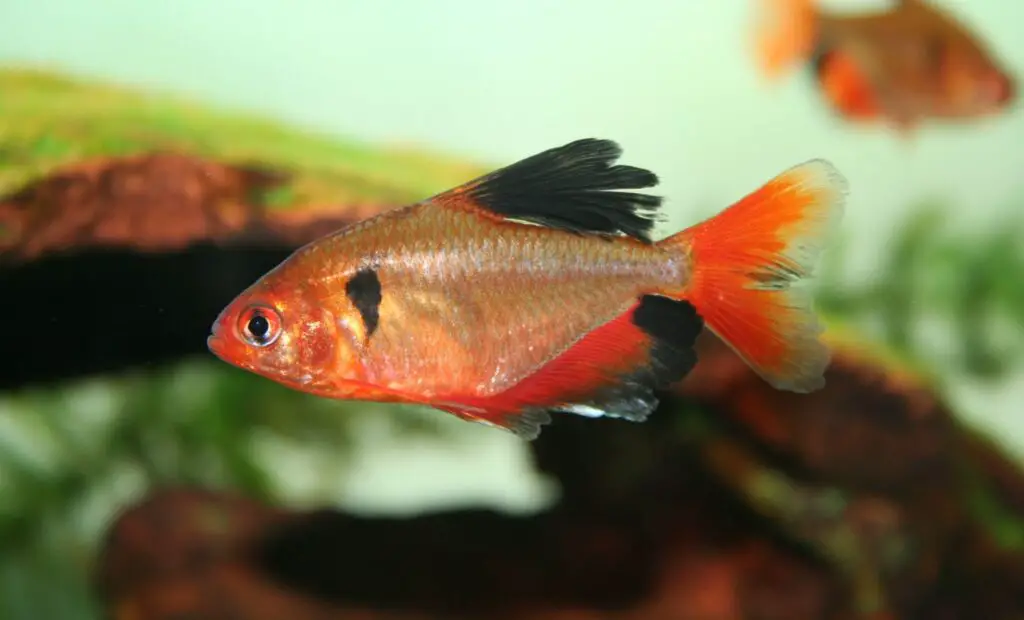
Origin, Habitat, and Distribution in the wild
The Serpae Tetras are one of the most colorful tetras that are widely available in various regions. It was 1882 when Steindachner described Serpae Tetra for the first time.
Back in the days, Serpae Tetras was classified as Hyphessobrycon Callistus and then later changed to Hyphessobrycon eques.
Serpae Tetras are the native habitats of areas around Amazon basins, Guapore, and Paraguay River basins in Argentina, Brazil, and upper Paraguay. In the wild, you can find Serpae Tetras commonly in slow-moving streams.
Most of the Serpae Tetra that you see in the market are captive bred. Meaning they are breaded in breeding facilities around the world. And only some of them are wild-caught. As we can easily find these tetras in the wild, they aren’t listed in the IUCN Red List.
The Serpae Tetras admires densely vegetated and stagnant waters of tributaries, ponds, and small lakes. They mostly swim close to the surface.
About Serpae Tetra
Serpae Tetra has growing popularity as one of the most beautiful aquarium fish. One of the alluring factors that these tetras have is their bright red color. This is the color that grabs your attention when you look at the tank with these tetras.
Serpae Tetras are a great addition to a beginner’s aquarium as these tetras are hardy fish; they can withstand harsh water parameters too. These tetras are inexpensive, too, so anyone can afford the fish.
Unlike most of the tetras, the Serpae Tetra has a twitchy spastic style of swimming. The Serpae Tetra tend to move in short bursts rather than swimming smoothly. As they are schooling fish looking at the pack moving together will relax your body and mind.
Serpae Tetra Appearance
The Serpae Tetras are one of the most beautiful aquarium fish to keep. The color of these tetras is deep red on the sides. These fish have olive-brown color on their side profiles. Some of the serpae tetras have an outstanding black dot visible on the gills.
The tetra’s dorsal fin is black and has white rims. The anal fin is black in color as well, and the tips are white. The remaining fins are entirely red.
The fully-grown Serpae Tetras is about 1 to 1.5 inches long. When viewed from the side, the body is an elongated oval, laterally compressed.
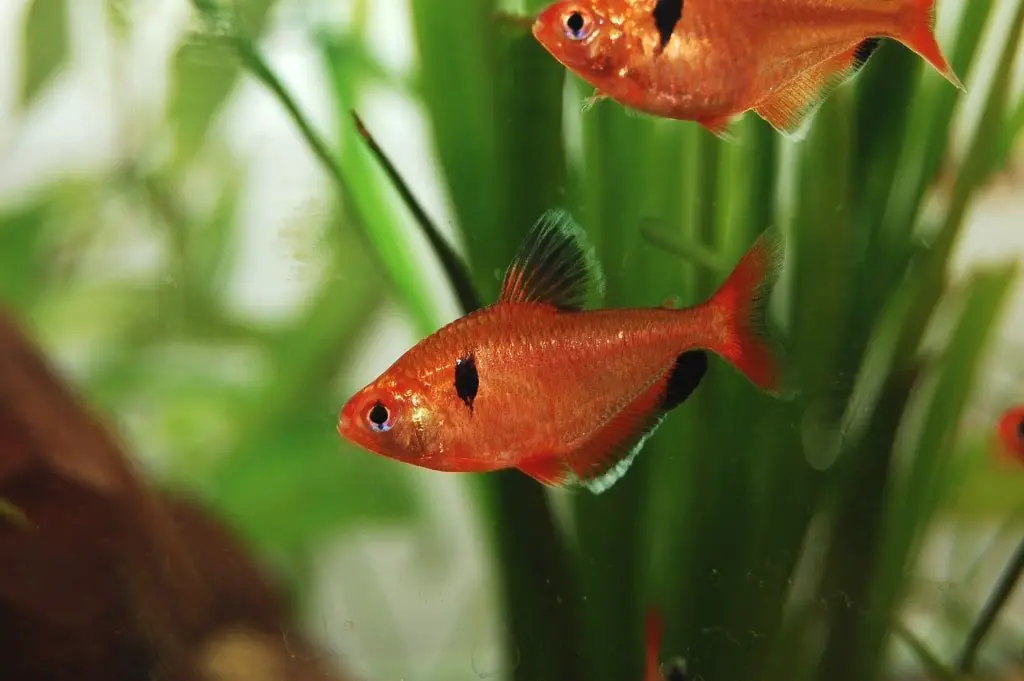
Serpae Tetra Availability
Serpae Tetras are very popular and widely available in different regions of South America, Argentina, Brazil, and Paraguay. These fish do not fall on the red list; thus, they are available in the wild as well.
Mostly the sellers breed these tetras in the community tank. Hence, they are available in pet stores and online stores that export Serpae Tetras to other countries as well.
The lifespan of Serpae Tetra
Like most tetras, Serpae Tetra has a life span of 3 to 7 years. If you can take care of them carefully, the fish can even live for more than seven years.
You need to keep your tetra fish happy and healthy if you want them to live longer in your aquarium.
There are reports of these tetras living for more than ten years in a very well-maintained aquarium.
Serpae Tetra Price
The Serpae Tetra is mostly bred in captivity and is available in most regions like South America, Argentina, Brazil, and upper Paraguay. The cost of these tetras can range from $1.99 to $2.49 per fish according to the place you live in.
How Difficult Is It To Keep Serpae Tetra?
Usually, Serpae Tetras are very easy to care for. As these tetras are schooling fish, you need to keep them in a group of at least 6. However, they do not get along with most of the other fish, especially smaller ones. This tetra can have a habit of fin nipping and the target of relentless harassment to the smaller fish.
The Serpae Tetras mostly get along with their own kind or of their own size. Once they are comfortable in their environment, they are very easy to care for and breed too.
Serpae Tetras are very hardy fish; they can adapt to a wide range of water parameters in an aquarium. This makes this fish one of the best fish for a beginner aquarist.
Sexual Difference
It’s a bit difficult for a beginner to differentiate the male and female serpae tetra fish. However, some traits might help you differentiate the sex of serpae tetra. The best time you can separate these fish is during their spawning period.
Male Serpae Tetras colors are lighter, and their body is slimmer; their dorsal fins are entirely black. Whereas during the spawning period, the female tetra’s dorsal colors are red, and their body is oval as compared to male tetra. The male Serpae Tetras can get aggressive during breeding and can scare off other males.
The female Serpae Tetras, even when they are not in the spawning season, have a more rounded body. In tetra fish, the females are mostly pale than the males. It is a similar case for the Serpae Tetra as the males look brighter and more colorful than females.
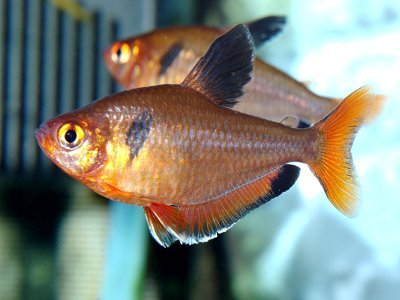
Serpae Tetra Fish Care
Since fish keeping is not the same as fostering other animals like cats and dogs, it can become a bit difficult in the beginning. However, once you understand the nature of the fish, you can take care of them better.
A proper diet and a clean environment play a vital role in upbringing the health of human beings. Fish are not so much different from us. They need the right environment, clean water, and a healthy diet to be able to live up to their full potential. If you are not able to manage their needs, they cannot be healthy. So, to take care of them, you must put a little bit of effort as they are living beings as well and deserve better living conditions.
To bring out Serpae Tetras’ activeness and brightness, you have to take care of their home. Read the following factors that you need to consider in caring for these tetras.
Tank Size For Serpae Tetra
When you want to pet a fish, you must know the different criteria that you should consider before. One of the requirements is the ideal tank size for tetra fish. The Serpae Tetras prefer a tank size of at least 20 gallons, the bigger the aquarium the better as they will have much more space to play. As these tetras are schooling fish, you will need to keep them in a group, and considering the group size and other fish in the tank, you might need to upgrade your tank to a higher volume. As for simple math, one inch of fish requires one gallon of tank. So, in the case of serpae tetra, you will need at least a 20-gallon tank for at most six tetra fish.
When choosing the tank for these tetras, you must make sure that fish get enough space to swim freely.
Lightings
There are different lighting choices for different kinds of fish. Most of the tetra fish choose to thrive in low lighting. Like most of the tetras, for Serpae tetra, to resemble natural habitat, use low and subdued lighting. The dark tank environment can bring out the best coloration in these fish.
When you are lighting the aquarium tank for Jewel Tetras, you must also consider that the lights you are using do not heat up the temperature of the water. You must always remember to switch the lights on and off every day at the same time as per the requirements of the tank environment.
Decorations and Substrate That Serpae Tetra Likes
Serpae Tetras need lots of hiding places as they get easily scared, and it is their way to keep themselves from harm’s way. Hence, for the tetras to feel secure, they need to live plants and vegetation inside the aquarium along with the dark substrate.
You need to select the best plants for your tetra tank that can provide Serpae tetra enough hiding space while serving the decorative purpose too.
The plantation must be around the corners as the serpae prefers to swim in the middle areas of the tank. Some of the decorations for the fish can be driftwood, fern plants like Anubias and Java.
The driftwood provides a natural look and feels in the tank environment. As well as the different plantations can cause a difference in the shade of water, reflecting their natural habitat.
Tfwadmx Natural Driftwood comes in a package of 4 and is very easy to clean due to its small size.
Best Fish Diet For Serpae Tetra
The Serpae Tetras are one of the easiest fish to handle. The fish is very less demanding and can eat almost anything with their omnivorous diet.
In the wild, Serpae Tetras can eat small live food such as insects, invertebrates, and worms. Whereas, in the aquarium, aquarists have to keep in mind the fish’s little mouth. Hence, you mustn’t feed huge chunks of food. These tetras diet mostly contain small live or frozen insects, worms, flakes, pellets, ground grains, vegetables like lettuce, dried Brine Shrimp, and bloodworms.
Serpae Tetras can consume a very small amount of food at a time. Therefore, you must always keep in mind that you do not overfeed them. You also need to remove any uneaten food within five minutes.
Maintain Water Quality
An important factor in taking care of the Serpae Tetra or any other species of fish is to uphold the quality of water. Water gives the fish life, and keepers should be able to provide them with a balanced environment.
The artificial habitat can be very difficult to keep up with for different fish. Luckily, Serpae Tetra can handle and adapt to the environment you have set up very quickly. The water parameters should not change drastically. There must be regularity in changing to clean water in the tetra tank bi-weekly.
You may be able to maintain the water quality by maintaining temperature, ph level, hardness, and the filtration system of the aquarium. They are described in detail further.
What’s The Best Temperature For Serpae Tetra
All the qualities inside the aquarium tank should be replicating the fish’s natural habitat. This means that since the Serpae Tetras are tropical fish, the water temperature inside the tank should mimic the warm water of the tropical rivers.
The temperature in the aquarium may have an impact on the health of these fish if it is not steady or drops below the ideal temperature. The temperature of the tank should be between 72 – 82°F (22-27°C).
There are many ways to maintain the temperature of the tetra tank but one of the best ways is to get an aquarium heater.
Aquarium heater helps to stabilize the water temperature and keeps it ideal all the time. Fluval M50 Submersible Heater is one of the highly recommended and best heaters for your tetra tank.
pH and Water Hardness
The Serpae Tetras prefer a lower ph range in their tank. As mentioned earlier, you must decorate their tank with driftwood. This driftwood can release tannins, which helps to maintain the lower pH level inside the tank.
The pH range for Serpae Tetras is from 5 to 7. They should not fluctuate drastically if you want the fish to thrive in the environment you have built. These tetras favor soft water, i.e., less than 60 ppm.
Filtration
Sometimes, the water inside the tank can change drastically due to the presence of various toxins and fish excreting. Thus, we need to filter out the possible toxins from the tank. Having a filter can help you to keep the tank clean.
In the case of Serpae Tetras, the filters are necessary to keep the tank oxygenated. This will help during the breeding of these fish as well. The filter installation helps to decompose nitrates, phosphates, and organic matter.
The aquarium tank is an artificial environment for Serpae Tetras. The artificial environment can have various fluctuations, and hence, installing filters can help you cope up with these factors.
There are various filtration methods and types of aquarium filters for tetra tank that will make your work easier. Tetra Whisper Internal Filter comes with an air pump as well that helps to oxygenate tank water while filtering the water.
Aquarium Water Maintenance
As water is the source of life for Serpae Tetra and other fish, keepers should not compromise or contaminate them. The factors such as temperature, pH level, hardness, and filtration of toxins should be regular.
When you do not take care of the Serpae Tetras environment and water, it can have an adverse effect on their health. The owner should understand the nature of the fish and maintain their environment.
Therefore, any fish keepers need to replicate the fish’s natural habitat as closely as possible.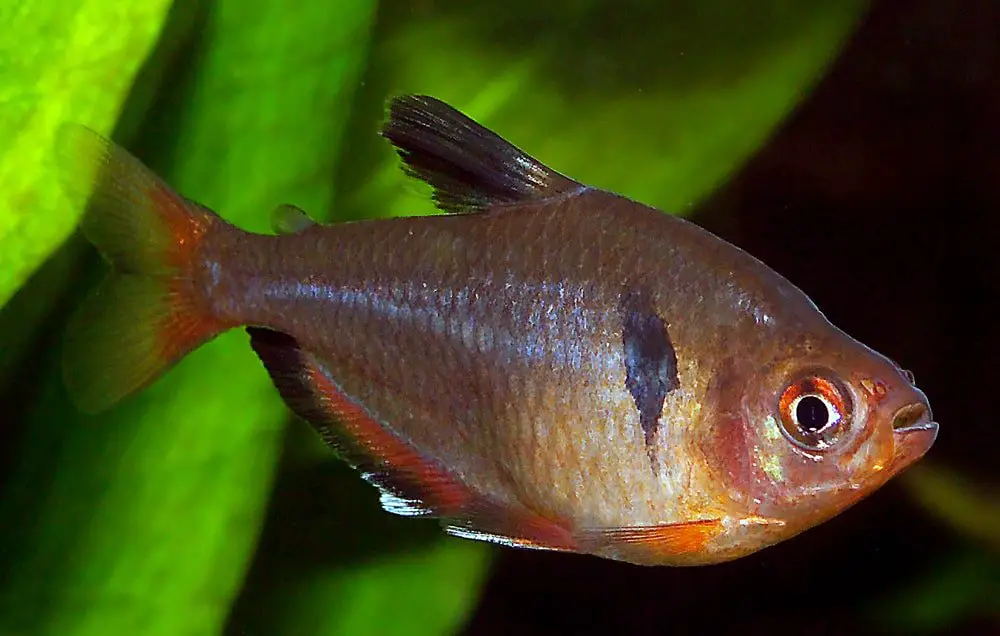
Serpae Tetra Tankmates
For most initial fish keepers, understanding the compatibility of different fish within a tank is a problem. They are not sure whether they can keep Serpae Tetras with other kinds of fish or keep them isolated. For this, you should first know the nature of this fish.
Like most tetras, Serpae Tetras are also very friendly fish. They do not do well in isolation and must always be in groups of 5 to 6.
The most frequently asked question about these tetras is, do they get along with other species? The answer, yes. The tank mates ideal for these tetra fish is active long fin tetras, like Barbs, Danios, and other larger tetras like rummy nose tetra. The fish also get along with bottom-dwelling fish.
However, you must know that Serpae Tetras do not get along with smaller species. These fish often harass and fight with the smaller ones. Other species that they do not tolerate are the slow-moving fish. These fish tend to nip the fins of less active and slow-moving fish, and hence, you should not keep them together in a tank.
Likewise, don’t keep the serpae tetra with aggressive and big fish, or else serpae tetra would be nothing but a dinner for these fish.
Additionally, you can also see Serpae Tetras fighting with other males within their own school. If this happens, you must not worry, as this is just the way of their playfulness. They do not severely harm each other.
Read Full Article on Serpae Tetra Tank Mates
Serpae Tetra Diseases
When you keep any kind of fish in a confined space, they are immune to many diseases. There is less chance of fish suffering from different diseases if you maintain the tank system and environment properly. Nevertheless, the fish are not prone to diseases.
Serpae Tetra is one of the hardy fish and can tolerate changes to their environment. As previously mentioned in this article, these fish like a heavy plantation in their tank.
Here is what you should keep in mind, anything you add inside the tank, whether it is plant or substrate or other fish, can disrupt the balance of the tank. When there is a disturbance within the tank, there can arise diseases.
Serpae Tetra has the best resilience to diseases, and you can control it before there is an outbreak. Sometimes it will be difficult to know the symptoms.
The best way to prevent disease is to provide the right environment and a balanced diet for your tetras. Keeping a closer look at the tank condition, their changes, and the diet of the fish can help improve their health.
You need to learn about Tetra Fish Diseases And Treatments to get a clear picture of what you need to do and what not to do.
The Serpae Tetras, just like many fish, are vulnerable to flukes in the skin infestations with parasites (protozoa, worms, etc.). The diseases also include ichthyobodo infection, parasite infestations (protozoa, worms, etc.).
Conclusion
These are the fundamental factors that you have to remember before you purchase Serpae Tetra. We hope that this article has helped you understand the dos and don’ts if you are interested in these tetras.
Finally, I hope that this article can help you make sure that your fish is always in good health and always maintain your aquarium water.
